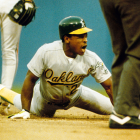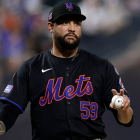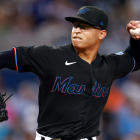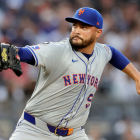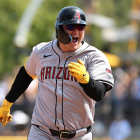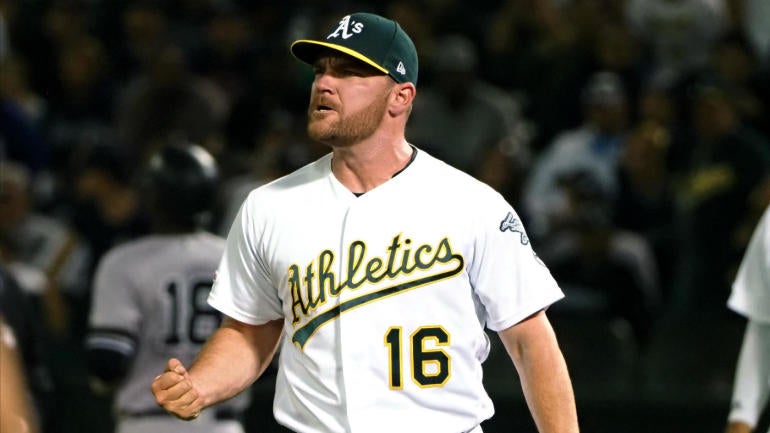
The arrival of Major League Baseball's offseason means that, among other things, it's now the time of the year when we're going to be ranking all kinds of things -- free agents, prospects, and so on. The process got underway earlier this month, when we rolled out our annual free-agent rankings. This year's list ran 60 deep, a nod toward the bloated free-agent class that resulted from teams declining affordable club options in a fiscally conservative response to the pandemic.
Continuing today, we'll be taking the next step with our free-agent rankings, breaking things down on a position-by-position basis. That process carries on with our top 10 relief pitchers.
Free-agent reliever rankings
| 1 |
Liam Hendriks
Oakland Athletics RP
|
| (No. 20 overall) The beauty of fastball-slider relievers is you never know which one is going to break out or when. Hendriks is a good example. Over the last two seasons, he's thrown 110 innings of 1.79 ERA ball, and has done so while striking out 161 and walking 24. Was there any real indication that this was coming? Not so much. In the preceding three years (all spent with the Athletics, mind you), he had a 4.01 ERA and a 3.64 strikeout-to-walk ratio. Anyway, here's hoping Hendriks receives the payday he deserves, especially after he followed in the footsteps of Nathan Eovaldi and Brandon Morrow this postseason, going above and beyond and risking injury despite his looming date with free agency. Selflessness ought to be rewarded, after all. | |
| 2 |
Brad Hand
Cleveland Indians RP
|
| (No. 21 overall) Cleveland declined the $10 million option held on Hand, which used to be viewed as a bargain. He doesn't throw as hard as he used to; his pitches generated fewer swings-and-misses than usual in 2020; and his batted-ball profile has shifted from ground- to air-based. All that said, did you look at his statline? There was no noticeable slippage or obvious decline in his performance. Rather, Hand posted the best ERA+ and strikeout-to-walk ratio of his career. Someone's going to entrust him with a high-leverage role; they just might get a bargain, too. | |
| 3 |
Pedro Baez
Los Angeles Dodgers RP
|
| (No. 34 overall) Perception is a powerful, often misleading thing. Take Baez for example. He's been a consistent, reliable, and valuable high-leverage reliever for as long as he's been in the Show, but your odds of convincing someone of that truth are akin to your chances of teaching a wildebeest how to play Connect Four. To wit, Baez is one of four relievers who have had an ERA+ exceeding 130 in each of the last five seasons. Those other three have all been entrusted with closer gigs and have accumulated more than 100 saves apiece. Not Baez, who is best known for his agonizing pace and his tendency to give up backbreaking home runs in October. To make matters worse, his velocity and his strikeout and walk rates all worsened in 2020. It's possible Baez's struggles were the product of an odd year; those woes, plus his danged perception, could cost him. | |
| 4 |
Alex Colome
Chicago White Sox RP
|
| (No. 35 overall) Colome has bounced around the league a fair amount over the last several years, which has obscured his level of production. Since moving to the bullpen on a full-time basis in 2016, he has the fifth-best ERA+ and the third-most saves among relievers with 200-plus appearances. Colome's formula for success is simple: he throws a lot of upper-80s cutters and complements it with enough mid-90s fastballs to keep hitters off-balance. It isn't always pretty, and sometimes he allows too much hard contact to feel at ease, but it's consistently worked for him. Expect him to continue to get high-leverage chances, and perhaps save opportunities, until it doesn't. | |
| 5 |
Blake Treinen
Los Angeles Dodgers RP
|
| (No. 36 overall) Treinen split the uprights between his last two seasons. He was adequate; not dominant, like he was in 2018, and not a mess, as with 2019. Treinen's game is "bend, don't break." The opposition hit better than .300 against his trademark sinker, yet the damage ratio was low enough that he was able to keep runs off the board. (Oddly, for someone who allowed so many singles and generated more than 60 percent grounders, he had a below-average double-play rate.) Dodgers skipper Dave Roberts used Treinen against right-handers more than usual, and that was a wise play given his career numbers. He'll likely land a high-leverage role based on his reputation, but suitors should accept him for what he is, not what he was once upon a time. | |
| 6 |
Trevor May
Minnesota Twins RP
|
| (No. 37 overall) Bill James once theorized that it's better for a player to start hot than to finish hot, even if their statistics end up the same. James' thinking was that the player who started hot would have better-looking numbers throughout, which would in turn buy them more leeway from management and fans. May is evidence that the inverse is true when it comes to paths to free agency: in his first three seasons in the Show, he posted a 5.14 ERA and looked like a bust; in his last three, he accumulated a 3.19 ERA and gained recognition as a legitimate high-leverage arm. Part of his improvement was a permanent move to the bullpen, where he's continued to seek the ideal pitch mix. Last season, that meant shelving his curveball and throwing more than 80 percent fastballs and sliders. It's an effective combination for missing bats; he's still home-run prone, however, which could prevent him from ever being viewed as a worthy closing option. | |
| 7 |
Trevor Rosenthal
Kansas City Royals RP
|
| (No. 38 overall) A year ago, it would've been fair to assume Rosenthal's big-league career was nearing its conclusion. He had walked 26 batters in 15 innings, and had one of the more embarrassing stretches of pitching in recent memory, failing to record an out in his first four appearances of the season. Rosenthal had a remarkable turnaround in 2020, completing the year with a 1.90 ERA and issuing just eight walks in 23 innings. He relied primarily on a 98-mph fastball and a slider, both of which missed bats more than 36 percent of the time. There is some reason to be skeptical about him sustaining that level of performance: he is, after all, only a year removed from a disaster of a season; and he threw more than 11 percent of his pitches in the "meatball" zone, according to Statcast. You might reason that Rosenthal's stuff is good enough to live there without being smoked, but his exit velocity ranked in the 14th percentile. | |
| 8 |
Shane Greene
Atlanta Braves RP
|
| (No. 46 overall) Timing is everything. Had Greene reeled off this two-season run (during which he accumulated a 199 ERA+ and recorded 23 saves) in, say, 2006 or 2007, then some team would be about to offer him a three- or four-year pact worth $20 million, easy. Teams these days are more likely to dig deeper, and more likely to conclude that Greene's success feels ... well, tenuous. Both his strikeout and walk rates went in the wrong direction last season, and each of his three primary pitches were less likely to generate a swinging strike than in the previous year. You can dig deeper and find reasons for discomfort on a granular level, too. For instance, opponents hit better than .260 against both Greene's sinker and slider, two pitches that accounted for nearly 60 percent of his total offerings. Oh, and don't forget about his career .820 OPS when faced with left-handed hitters -- Lord knows opposing managers won't. Greene's still going to have suitors because of his topline numbers, but there's a real chance he flunks out of high-leverage work. | |
| 9 |
Mark Melancon
Atlanta Braves RP
|
| (No. 47 overall) On the one hand, it's easy to envision Melancon cutting and curving his way to another solid season or two. On the other, his whiff rate cratered this year, to the extent that it's a little worrisome. Batters went from missing on more than a quarter of their swings against his pitches to missing on less than 20 percent. Melancon still generated a lot of weak contact on grounders, and that's more or less the key to him remaining employable heading forward. | |
| 10 |
Kirby Yates
San Diego Padres RP
|
| (No. 48 overall) You have to feel for Yates, who likely entered the year dreaming of signing a lucrative, multi-year contract this winter. Those dreams were dashed quickly, as he made just six appearances before undergoing season-ending elbow surgery to deal with some bone chips. When he's been healthy, he's been highly effective over the last three-plus seasons, compiling a 2.55 ERA and 14 strikeouts per nine innings as a member of the Padres. Yates will probably have to settle for a one-year deal, maybe with a player or vesting option attached, to prove that he's back to good. Then, maybe, he can get the fat free-agent deal that his recent work merits. | |



















